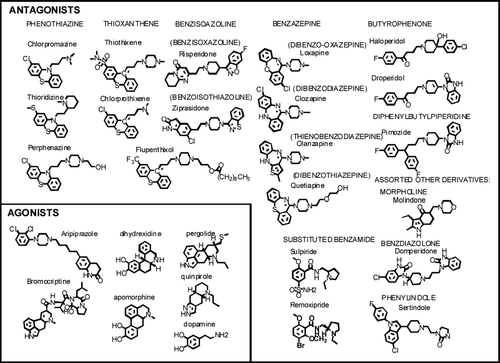In Journal of Receptors and Signal Transduction, 24(3): 207–239, 2004 for the article “Dopamine Receptor Microdomains Involved in Molecular Recognition and the Regulation of Drug Affinity and Function,” incorrect data was included. The affected items appear in corrected form below.
Page 209, Section II, Paragraph 2, Sentence 1, should appear as: Substitution of the primary amine of dopamine with a quaternary trimethylamine (DA-N(Me)3) results in a large reduction in the binding to the agonist high-affinity and low-affinity state of the receptor (263-fold and 199-fold, respectively, ) (9).
Table 1 Affinity and potency values for dopamine, and its uncharged and permanently positively-charged analogs and bioisosters
Page 212, Paragraph 1, Sentence 3, should appear as: Although the dopamine-like dimethylselenonium and dimethylsulfonium derivatives had drastically reduced affinity for the high-affinity state, their potency was only moderately decreased (4.7-fold and 12-fold, respectively, ) (9). Page 212, Paragraph 2, Sentence 2, should appear as: For instance, substitution of the dimethylamino group of the phenothiozine chlorpromazine for permanently charged quaternary trimethylamino or dimethylsulfide groups drastically reduces binding affinity (1792-fold and 233-fold respectively) and moderately reduces the potency of functional antagonism (11-fold and 19-fold, respectively; ) (12).
Table 2 Affinity and potency values for the sodium-sensitive substituted benzamide antagonists metclopramide and sulpiride, and the sodium-insensitive phenothiozine antagonist chlorpromazine, and their differentially-charged analogs and bioisosters
Table 4 Affinity values for the binding agonists and antagonists to cloned wild type D3 dopamine receptors and the corresponding S5.42A, S5.43A, and S5.46A mutants
Table 8 Affinity values for the binding of antagonists to cloned wild type D2 dopamine receptor and the corresponding S5.42C, S5.43C, and S5.46C mutants
Table 9 Affinity of various non-selective or moderately-selective mono- or disubstituted aromatic piperidinyl/piperizinyl antagonists
Page 226, Paragraph 1, Sentence 6, should appear as: The D1-S5.43A mutant has reduced affinity for the catechol-containing agonists SKF38393 and SKF82958 (4.5-fold and 13-fold, respectively) and an even greater reduction in affinity for the structural analogue antagonist SCH23390 (72-fold; ) (24).
Page 229, Paragraph 2, Sentence 8, should appear as: The H6.55 must be acting as an H-bond donor in this interaction, because neither cysteine nor leucine can donate H-bonds and sultopride can only act as an H-bond acceptor.
Page 229, Paragraph 2, Sentence 10 should appear as: The D2-F6.52C mutant had only slightly reduced affinity (3- to 4-fold) for [3H]methylspiperone and [3H]sulpiride (30), but the affinity for [3H]methylspiperone, [3H]raclopride, [3H]N-0437 was abolished in a D2-F6.52A mutant (36).
Page 230, Section VI, Paragraph 1, Sentence 4 should appear as: In the case of the β 2-adrenergic receptor, the charge-neutralizing mutations, D3.49N, E6.30A, and E6.30Q, increase both basal and pindolol-stimulated cAMP accumulation relative to the wild-type receptor (38).
Page 231, Section VIII, Paragraph 1, Sentence 4 should appear as: Furthermore, the affinity for another benzazapine antipsychotic olanzapine is also decreased about 2-fold, even though olanzapine has higher affinity for D2 over D4 receptors (3.5-fold) whereas the more D2-selective (14-fold) benzazapine quetiapine is insensitive to this same D4-F2.61V mutation () (42).
